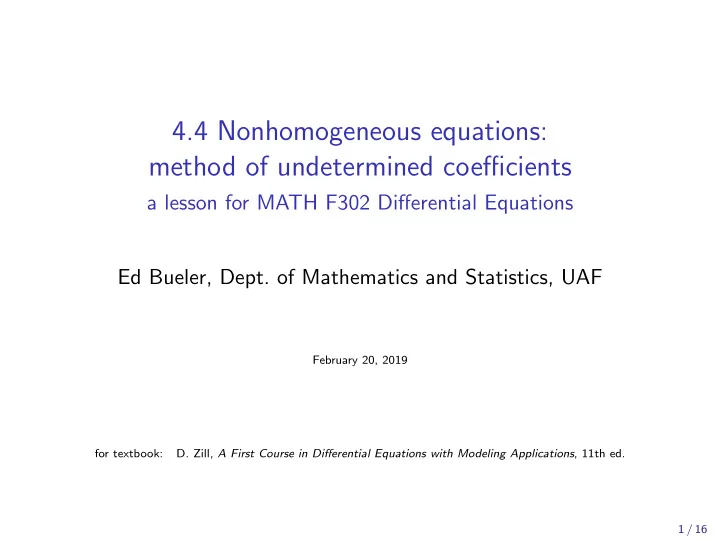

4.4 Nonhomogeneous equations: method of undetermined coefficients a lesson for MATH F302 Differential Equations Ed Bueler, Dept. of Mathematics and Statistics, UAF February 20, 2019 for textbook: D. Zill, A First Course in Differential Equations with Modeling Applications , 11th ed. 1 / 16
general solutions to nonhomogeneous DEs • for an n th-order, linear, and nonhomogeneous DE a n ( x ) y ( n ) + a n − 1 ( x ) y ( n − 1) + · · · + a 1 ( x ) y ′ + a 0 ( x ) y ∗ = g ( x ) • . . . the general solution is a sum of the general solution of the associated homogeneous equation a n ( x ) y ( n ) + a n − 1 ( x ) y ( n − 1) + · · · + a 1 ( x ) y ′ + a 0 ( x ) y = 0 plus one particular solution y p ( x ) of ∗ ◦ the general solution of the homogeneous equation is called the complementary function y c ( x ) • main structure: y ( x ) = y c ( x ) + y p ( x ) solves ∗ 2 / 16
example 1 • example 1 : find the general solution: y ′′ + 4 y = e − x 3 / 16
example 1, cont. 5 e − x solves • verify that y ( x ) = c 1 cos 2 x + c 2 sin 2 x + 1 y ′′ + 4 y = e − x 4 / 16
example 1, cont. 2 • solve the initial value problem: y ′′ + 4 y = e − x , y ′ (0) = 1 y (0) = − 1 , 5 / 16
example 2 • the idea of “undetermined coefficients” is to try y p ( x ) which has the same general form as the nonhomogeneity g ( x ) • example 2 ( ≈ #5 in 4.4) : find the general solution: y ′′ + 4 y ′ + 4 y = x 2 − 2 x 6 / 16
example 3 • example 3 (#8 in 4.4) : find the general solution: 4 y ′′ − 4 y ′ − 3 y = cos 2 x 7 / 16
trial forms for the particular solution • we need some guidance on how to guess! • in words: For y p try a linear combination of all linearly-independent functions generated by repeated differentiation of g ( x ) . • as a table: 8 / 16
example 4 shows we still have issues! • example 4 ( ≈ #13 in 4.4) : find the general solution: y ′′ + 9 y = 2 cos 3 x 9 / 16
guidance on the hard case • the problematic case happens when our guess for y p “accidently” contain terms which also appear in y c ◦ because the left side then annihilates those terms ◦ . . . which blocks us from determining y p • guidance in words: If the trial form of y p contains terms that duplicate terms in y c then multiply the trial form by x n where n is the smallest power that eliminates the duplication. 10 / 16
example 5 • example 5 (#29 in 4.4) : solve the initial value problem: 5 y ′′ + y ′ = − 6 x , y ′ (0) = − 10 y (0) = 0 , 11 / 16
example 6 • example 6 (#32 in 4.4) : solve the initial value problem: y ′′ − y = cosh x , y ′ (0) = 12 y (0) = 2 , 12 / 16
example 6, cont. • the last slide had an impressive calculation, so we should . . . • verify that y ( x ) = 7 e x − 5 e − x + 1 4 xe − x solves 4 xe x − 1 y ′′ − y = cosh x , y (0) = 2 , y ′ (0) = 12 13 / 16
clearly • clearly you need to practice examples, not just me 14 / 16
what we are skipping next we are skipping the following sections: • § 4.5 Undetermined Coefficients—Annihilator Approach a more abstract view of undetermined coefficients . . . but no more powerful than our superposition method • § 4.6 Variation of parameters a general approach to nonhomogeneous linear equations but one may not be able to compute the integrals you get ◦ it is somewhat like reduction of order in § 4.2 • § 4.7 Cauchy-Euler equations another class of homogeneous differential equations which can be solved via an auxiliary equation • § 4.8 Green’s Functions mostly relevant to boundary value problems (not in Math 302) • § 4.9 Solving Systems of Linear DEs by Elimination a way of solving systems . . . which are important . . . but done generally and powerfully in chapter 8 15 / 16
expectations • just watching this video is not enough! ◦ see “found online” videos at bueler.github.io/math302/week7.html ◦ read section 4.4 in the textbook ◦ do the WebAssign exercises for section 4.4 16 / 16
Recommend
More recommend